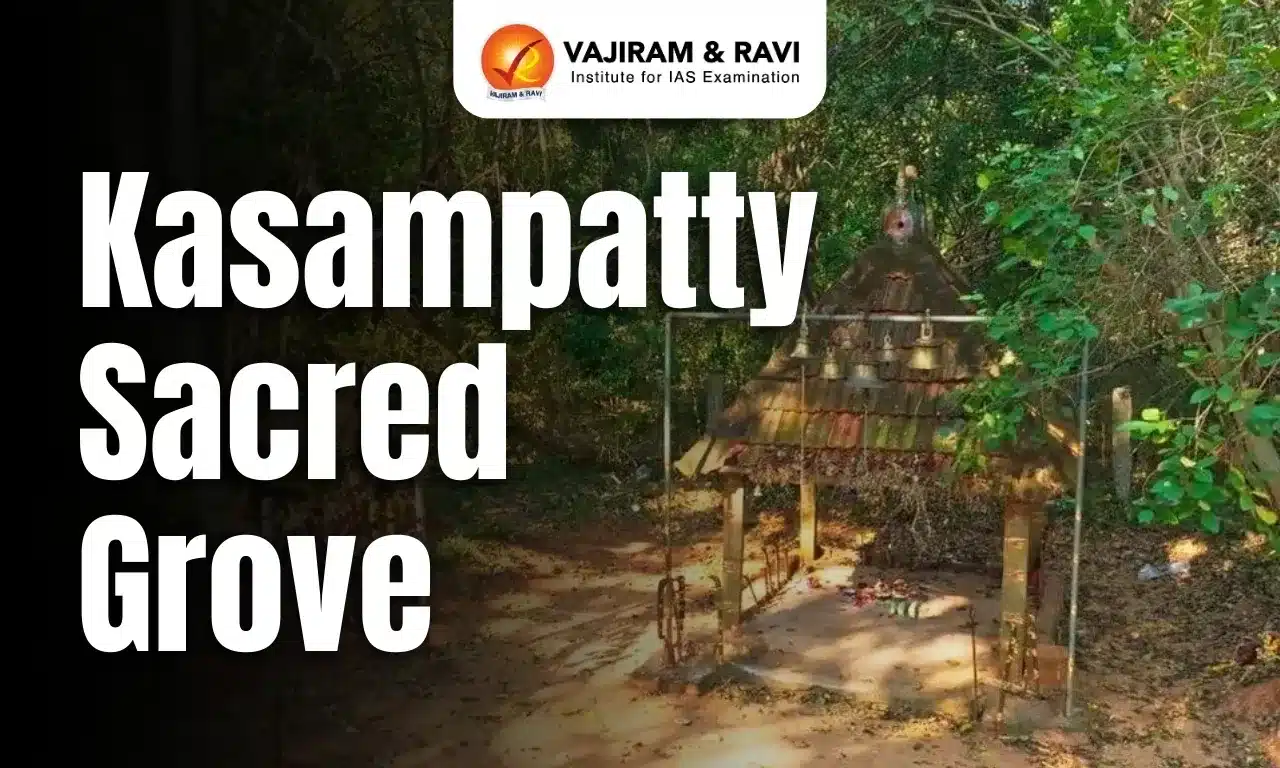Kasampatty Sacred Grove Latest News
The Tamil Nadu government recently notified Kasampatty (Veera Kovil) sacred grove as a Biodiversity Heritage Site.
About Kasampatty Sacred Grove
- The Kasampatti Sacred Grove, also known as Veera Kovil Sacred Grove, is a revered ecological and cultural site located in Kasampatti village, Dindigul District, Tamil Nadu.
- Spanning 4.97 hectares near the Alagarmalai Reserve Forest, this grove is enveloped by lush mango plantations, enhancing its natural beauty and fertility.
- It hosts an impressive variety of species – 48 plant species, 22 shrubs, 21 lianas (woody vines), and 29 herbs.
- It also shelters more than 12 species of birds, along with small mammals, reptiles, and numerous insects, highlighting the grove’s genetic richness.
- The Tamil Nadu government has notified Kasampatti Sacred Grove as the state’s second Biodiversity Heritage Site under the Biological Diversity Act, 2002.
What are Biodiversity Heritage Sites (BHS)?
- BHS are unique ecosystems having rich biodiversity comprising any one or more of the following components:
- Richness of wild as well as domesticated species or intra-specific categories.
- High endemism.
- Presence of rare and threatened species, keystone species, and species of evolutionary significance.
- Wild ancestors of domestic/cultivated species or their varieties.
- Past preeminence of biological components represented by fossil beds and having significant cultural, ethical, or aesthetic values and are important for the maintenance of cultural diversity, with or without a long history of human association with them.
- Under Section 37 of the Biological Diversity Act, 2002, the State Government, in consultation with local bodies, may notify areas of biodiversity importance as BHS.
- The State Government, in consultation with the Central Government, may frame rules for the management and conservation of BHS.
- The creation of BHS may not put any restriction on the prevailing practices and usages of the local communities other than those voluntarily decided by them.
- The purpose of declaring BHS is to enhance the quality of life of the local communities through the conservation of such sites.
- In 2007, the Nallur Tamarind Grove in Bengaluru, Karnataka, was designated as India’s first BHS.
Kasampatty Sacred Grove FAQs
Q1. Where is the Kasampatty Sacred Grove located?
Ans. Kasampatti Village, Dindigul District, Tamil Nadu
Q2. What is the primary purpose of declaring an area as a Biodiversity Heritage Site (BHS)?
Ans. To enhance the quality of life of local communities through conservation
Q3. The Nallur Tamarind Grove, the first BHS in India, is located in which city?
Ans. Bengaluru
Source: TG
Last updated on June, 2025
→ UPSC Notification 2025 was released on 22nd January 2025.
→ UPSC Prelims Result 2025 is out now for the CSE held on 25 May 2025.
→ UPSC Prelims Question Paper 2025 and Unofficial Prelims Answer Key 2025 are available now.
→ UPSC Calendar 2026 is released on 15th May, 2025.
→ The UPSC Vacancy 2025 were released 1129, out of which 979 were for UPSC CSE and remaining 150 are for UPSC IFoS.
→ UPSC Mains 2025 will be conducted on 22nd August 2025.
→ UPSC Prelims 2026 will be conducted on 24th May, 2026 & UPSC Mains 2026 will be conducted on 21st August 2026.
→ The UPSC Selection Process is of 3 stages-Prelims, Mains and Interview.
→ UPSC Result 2024 is released with latest UPSC Marksheet 2024. Check Now!
→ UPSC Toppers List 2024 is released now. Shakti Dubey is UPSC AIR 1 2024 Topper.
→ Also check Best IAS Coaching in Delhi
























